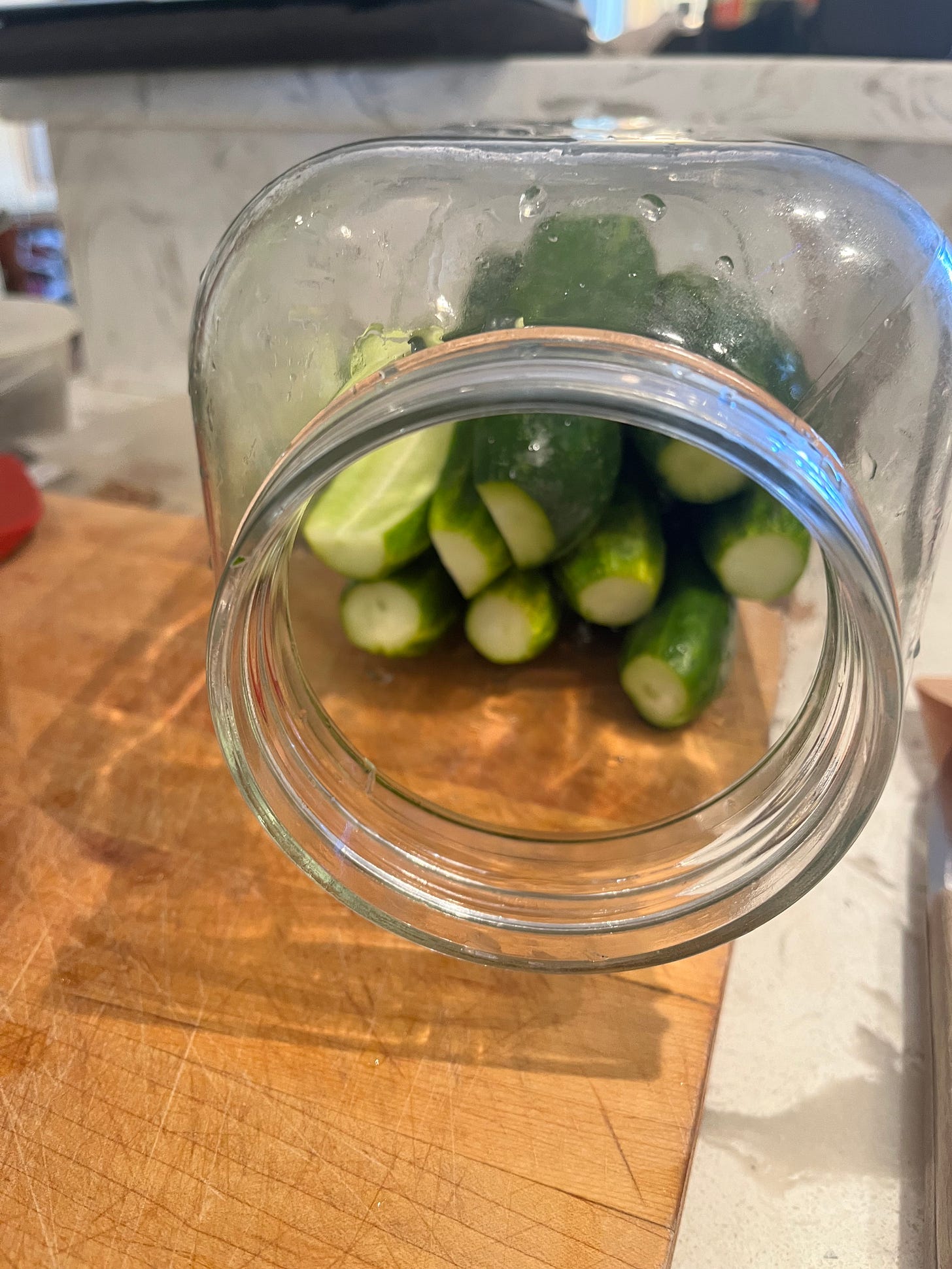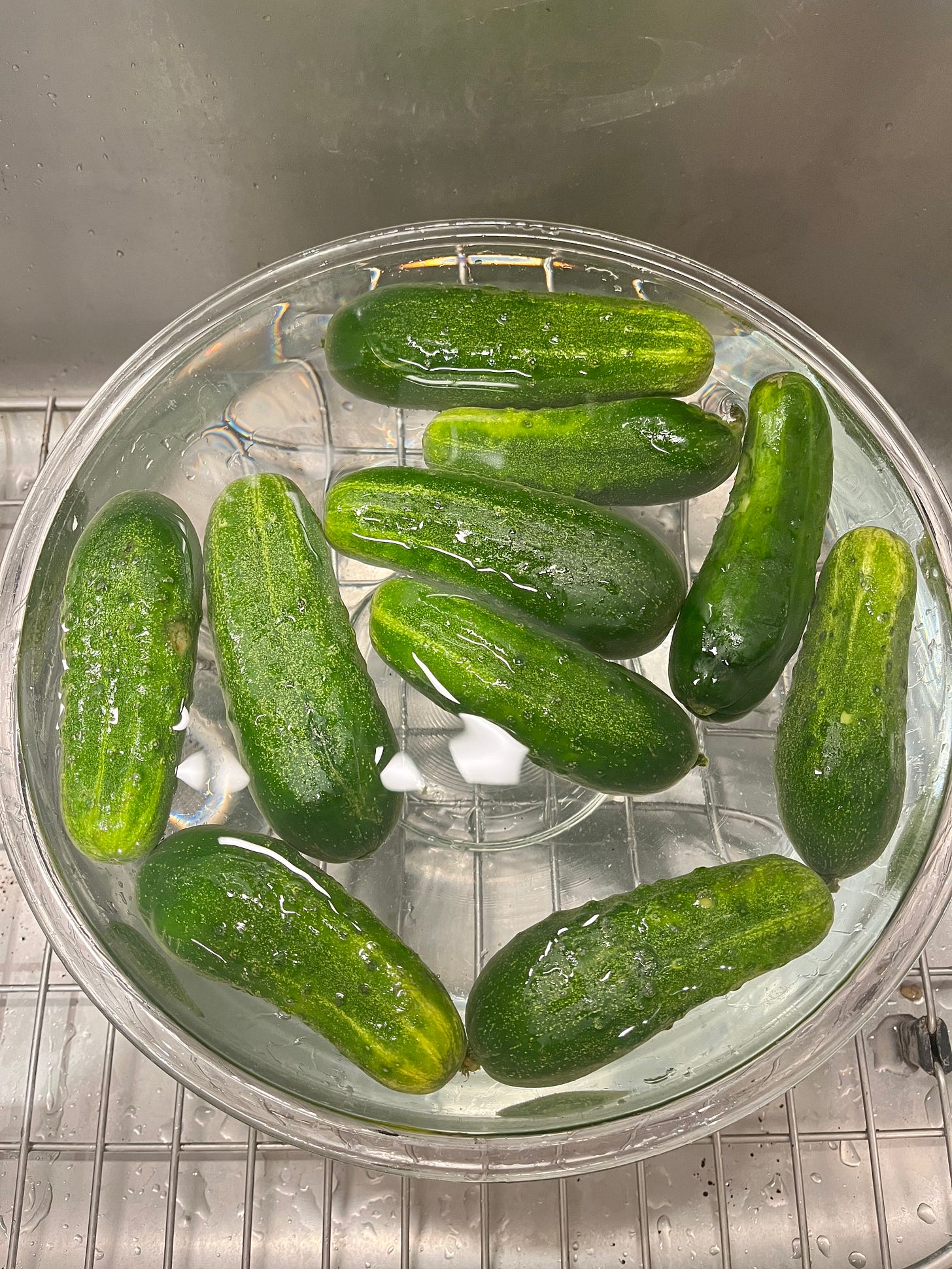Dill Pickles
We’ll make wonderfully sour cucumber pickles by submerging them in a seasoned brine for a few days.
The pickles in this recipe aren’t going to taste like the ones you buy at the supermarket—the kind soaked in vinegar—but rather like the kosher pickles you might find at a Jewish deli. The sourness in these pickles comes from the fermentation that takes place while the pickles are submerged in brine, which is made by dissolving coarse pickling salt in water—the same mix I use when I brine meat or fish before cooking (as in my salmon recipe).
Eating fermented foods is very healthy and the best way to make sure your digestive tract’s microbiome is healthy and balanced (see note1).
The seasoning includes dill seeds (or fresh dill if you have it), black peppercorns, allspice berries, coriander seeds, mustard seeds, red pepper, bay leaves, and garlic, so go check your pantry and see if you have those things. If you don’t and you’re not inclined to stock up on the missing spices, I would at a minimum have the dill, bay leaves, and garlic—the bay leaves are essential for keeping the pickles crunchy.
For this recipe, you’ll need a glass jar large enough to hold 10 or so pickling cucumbers (depending on their size)—I like to use a 3-quart jar with a swing-top lid—and a glass jar that is small enough to fit inside the mouth of the larger jar.
Ingredients:
Small pickling-sized cucumbers, such as Kirby or Persian cucumbers—as many as will fit snuggly in the jar you’ve selected (at least 1 pound)
For the pickling spice:
1 teaspoon dill seeds (see note2)
1 teaspoon black peppercorns
1 teaspoon allspice berries
1 teaspoon coriander seeds
1 teaspoon mustard seeds
1 teaspoon crushed red pepper or 1 to 2 dried red chilis (to taste)
10 bay leaves, crumbled (see note3)
4 cloves of fresh garlic, peeled and crushed under the flat side of a chef’s knife
For the brine:
1 quart water
¼ cup coarse sea salt or pickling salt (see note4)
Directions:
Put the water in a pan and bring it to a simmer
When the water is hot, remove it from heat, add the salt and pickling spices, and stir until the salt dissolves, making the brine (see note5)
While the brine cools, wash the cucumbers and cut a thin slice off both ends to remove the stem and blossom end (see note6)
Place the cucumbers snuggly side by side in the jar—try to have enough to fill the whole jar (see note7)—and add the peeled garlic
Once the brine has cooled to near room temperature, pour it into the jar over the cucumbers, making sure it covers the tops of the cucumbers (see note8)
Place the smaller jar inside the mouth of the larger jar to make sure the pickles stay submerged in the brine
Leave the pickle jar on the counter for up to 3 days before covering it with a lid and moving it to the refrigerator (see notes9 10)


A great cookbook to introduce you to the health benefits of fermented foods and other nutrient-rich foods is Sally Fallon’s Nourishing Traditions.
I have used either dill seeds or fresh dill leaves for this recipe. If using fresh dill, use about a half a cup and put it in the bottom of the large jar before packing in the cucumbers.
Do not skimp on bay leaves! The tannins from the bay leaves will keep the cucumbers crunchy.
I use coarse Korean sea salt that can be purchased in large bags at Korean supermarkets like Lotte. Korean sea salt is what is used when making kimchi, so is perfect for all kinds of fermentation recipes.
I like to add the spices to the hot water to extract more of the flavors and tannins from the spices.
I’ve had a lot of trial and error with pickling cucumbers in this way, and one of the problems I’ve had to overcome is having the cucumbers get mushy. I’ve consulted with others who do this and have found that two things will help keep the pickles crisp. The first is using plenty of bay leaves for the tannins, as I mentioned above. The second is cutting off the blossom end of the cucumber. Apparently, the blossom end contains enzymes that will contribute to the pickle becoming soft over time; at least, that’s how it’s been explained to me. If you know any more about this, please let me know in the comments.
You can quarter the cucumbers for spears if you prefer. I have done both whole cucumbers and spears many times, but I generally now do them whole.
What to do if there’s not enough brine to cover the cucumbers? Make another small batch of brine, using 1 tablespoon of salt per cup of water. You don’t need to add more of the spices.
The longer the pickles sit, the more sour they will become. People will disagree about how long you should let them sit at room temperature, but I’ve found that 3 days results in a taste that I like. It is normal for the brine to become cloudy after the first day or so.
When the pickles are all eaten, don’t throw away the brine! I make a tonic with it, using about 1 part pickle juice to 3 parts water. It’s a very healthy





